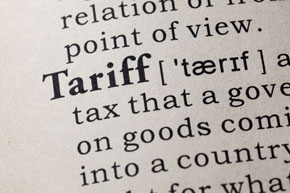Tariff Increases and the Potential Economic Effects

Changes to U.S. trade policy have sparked questions about what the economic effects might be. A recent Economic Synopses looked at other countries that increased tariffs to see what might happen.
Economist Fernando Leibovici and Senior Research Associate Jonas Crews identified 16 times over the period 1980-2006 when a country increased import tariffs by at least 3.5 percentage points in a year. The authors chose 3.5 percentage points to ensure enough data for their analysis. If countries had multiple such episodes, only the first episode was used. They examined what happened from the year before the increase through the following five years from two vantage points:
- Imports
- Key macroeconomic variables
Tariff Increases and Imports
The authors found that tariff increases were persistent through five years. That is, tariffs remained persistently higher for at least five years following the increase.
They also found that the imports-to-GDP ratio decreased gradually following tariff increases, dropping close to 2.5 percentage points over the first four years after an increase.
Tariff Increases and Key Macroeconomic Variables
Leibovici and Crews also examined GDP per capita, the investment-to-GDP ratio and total annual wages for each country following tariff increases. They found that GDP per capita and wages each fell around 2 percentage points relative to trend over the first two years after an increase.
They also noted that the investment-to-GDP ratio declined by about 1 percentage point, with the decline persistent over five years.
Important Notes
“While these figures show that past tariff increases have been typically followed by large and persistent decreases in economic activity, this evidence does not necessarily mean that the higher tariffs caused these changes,” the authors wrote. “It is possible that other economic events might have driven tariff increases and (slightly later) recessions.”
Notes and References
1 The authors chose 3.5 percentage points to ensure enough data for their analysis. If countries had multiple such episodes, only the first episode was used.
Additional Resources
- Economic Synopses: What Happens When Countries Increase Tariffs?
- On the Economy: When Does Trade Adjust after Being Liberalized?
- On the Economy: China’s Tariff Retaliation: How Many US Jobs May Be Affected?
Citation
ldquoTariff Increases and the Potential Economic Effects,rdquo St. Louis Fed On the Economy, June 26, 2018.
This blog offers commentary, analysis and data from our economists and experts. Views expressed are not necessarily those of the St. Louis Fed or Federal Reserve System.
Email Us
All other blog-related questions

